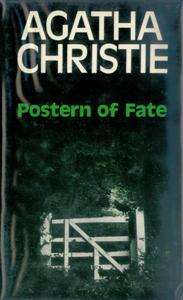Postern of Fate
Postern of Fate is a work of detective fiction by Agatha Christie that was first published in the UK by the Collins Crime Club in October 1973[1] and in the US by Dodd, Mead and Company later in the same year.[2][3] The UK edition retailed at £2.00[1] and the US edition at $6.95.[3]
 Dust-jacket illustration of the first UK edition | |
| Author | Agatha Christie |
|---|---|
| Cover artist | Margaret Murray |
| Country | United Kingdom |
| Language | English |
| Genre | Crime novel |
| Publisher | Collins Crime Club |
Publication date | October 1973 |
| Media type | Print (hardback & paperback) |
| Pages | 256 pp (first edition, hardcover) |
| ISBN | 0-00-231190-9 |
| OCLC | 2736294 |
| 823/.9/12 | |
| LC Class | PZ3.C4637 Pq3 PR6005.H66 |
| Preceded by | Elephants Can Remember |
| Followed by | Poems |
The book features her detectives Tommy and Tuppence Beresford and is the detectives' last appearance. It is the last novel Christie wrote, but not the last to be published as it was followed by two previously unpublished novels from the 1940s.
It is one of only four Christie novels not to have received an adaptation of any kind, the others being Death Comes as the End, Destination Unknown, and Passenger to Frankfurt.
Explanation of the Title
The title comes from the poem Gates of Damascus by James Elroy Flecker. The poem is also referenced in the short story The Gate of Baghdad in the 1934 collection Parker Pyne Investigates.
Plot summary
Now in their seventies (though the author never states their age clearly), Tommy and Tuppence move to a quiet English village, looking forward to a peaceful retirement. But, as they soon discover, their rambling old house holds secrets. Who is Mary Jordan? And why has someone left a coded message in an old book about her "unnatural" death? Once more, ingenuity and insight are called for as they are drawn into old mysteries and new dangers.
Literary significance and reception
Most critics remarked how noticeable Christie's advanced age is here. For example, the main characters Tommy and Tuppence, also of advanced age, seem to forget in one chapter what they discussed in the previous chapter. Some conversations seem to be repeated again and again, before any action takes place. Some puzzles which are obvious and easy to solve for the reader take chapters to be tackled by the main characters.
Maurice Richardson in The Observer of 11 November 1973 was positive in his review: "Now in their seventies, the Beresfords, that amateur detective couple of hers whom some of us found too sprightly for comfort, have acquired a Proustian complexity. A code message in an Edwardian children's book puts them on to the murder of a governess involved in a pre-1914 German spy case. Past and present go on interlocking impressively. Despite political naivety; this is a genuine tour de force with a star part for Hannibal, the Manchester Terrier."[4]
Robert Barnard wrote negatively that Postern of Fate was "The last book Christie wrote. Best (and easily) forgotten."[5]
According to The Cambridge Guide to Women's Writing in English, this novel is one of the "execrable last novels" in which Christie purportedly "loses her grip altogether".[6]
A Canadian study which compared the texts of a number of Christie novels indicated that her later works, including Postern of Fate, showed a 30% decrease in vocabulary. This change, along with the use of indeterminate words and repetitiveness, are indicative of Alzheimer's disease, although Christie was never diagnosed with the disorder.[7]
Publication history
- 1973, Collins Crime Club (London), October 1973, Hardcover, 254 pp
- 1973, Dodd Mead and Company (New York), Hardcover, 310 pp
- 1974 Bantam Books, Paperback, 276 pp
- 1974 GK Hall & Co. Large-print Edition, Hardcover, 471 pp; ISBN 0-8161-6197-6
- 1976, Fontana Books (Imprint of HarperCollins), Paperback, 221 pp
- 1992, Ulverscroft large-print Edition, Hardcover; ISBN 0-7089-2708-4
References to other works
The book has many references to other Tommy and Tuppence books as well as cultural references. We learn that Tuppence and Tommy's twin daughter Deborah is now mother of three children, that the adopted daughter Betty lives in Kenya and that the wife of Albert, the loyal valet, has recently died. Mr Robinson, the "yellow, big man" from Passenger to Frankfurt appears here, as do Colonel Pikeaway and Horsham, the latter posing undercover as a gardener.
References
- Collins Crime Club – A checklist of First Editions Chris Peers, Ralph Spurrier and Jamie Sturgeon. Dragonby Press (Second Edition) March 1999 (p. 15)
- Cooper and Pyke. Detective Fiction – the collector's guide: Second Edition (pp. 82, 87) Scholar Press. 1994; ISBN 0-85967-991-8
- "American Tribute to Agatha Christie". Retrieved 12 June 2016.
- The Observer, 11 November 1973 (p. 36)
- Barnard, Robert. A Talent to Deceive – an appreciation of Agatha Christie – Revised edition (p. 203). Fontana Books, 1990; ISBN 0-00-637474-3
- Sage, Lorna (1999). The Cambridge Guide to Women's Writing in English. Cambridge University Press. p. 132. ISBN 0-521-66813-1.
The Cambridge Guide to Women's Writing in English.
- Alison Flood. "Study claims Agatha Christie had Alzheimer's | Books". The Guardian. Retrieved 12 June 2016.